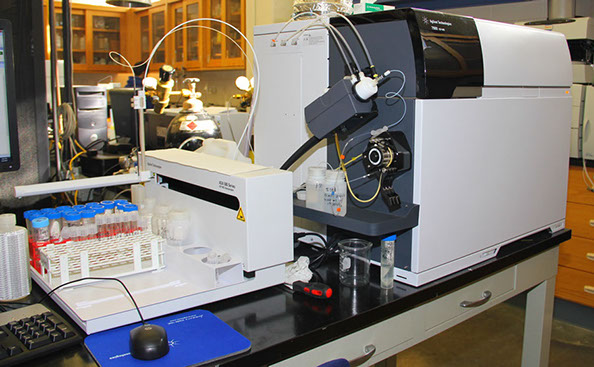Inductively Coupled Plasma Mass Spectrometry (ICP-MS)
Inductively Coupled Plasma Mass Spectrometry or ICP-MS is an analytical technique used for elemental determinations. An ICP-MS combines a high-temperature ICP source with a mass spectrometer. The ICP source converts the atoms of the elements in the sample to ions. These ions are then separated and detected by the quadruple mass spectrometer.

sample Injection
Ar(g)
ICP Torch
Sample Aerosol
Ion Optics
Sampling Interface
RF Coil
Ions
Mass Analyzer
quadrapole rods
Ion Detector
ICP-MS has many advantages over other elemental analysis techniques such as atomic absorption and optical emission spectrometry (AAS, AES), including: lower detection limits, higher throughput, ability to handle both simple and complex matrices with a minimum of matrix interferences, and more importantly, in our research, obtain isotopic information.
In our work, ICP-MS is heavily used for elemental analysis in dissolution studies, in particular dissolved Fe analysis. We have access to a Agilent 7900 ICP-MS located in Bureau of Geology & Mineral Resources at NMT. This is coupled to a ASX-500 auto sampler to enhance the efficiency and easiness of operation.
This features with higher matrix tolerance, wider dynamic range and better signal to noise than many other ICP-MS systems. Better trace level detection—novel interface design and optimized expansion-stage vacuum system increase ion transmission, providing >109cps/ppm sensitivity at <2% CeO, while the ODS provides increased gain and reduced background for improved signal to noise.

ADMINISTRATIVE ASSISTANT
GAYAN R. RUBASINGHEGE
Associate Professor of Chemistry
New Mexico Institute of Mining and Technology
Department of Chemistry
801 Leroy Place
Socorro, NM 87801
Bethany Jessen
New Mexico Institute of Mining and Technology
Department of Chemistry
801 Leroy Place
Socorro, NM 87801
Phone: 575-835-5129
Fax: 575-835-5215
Phone: 575-835-5263
Fax: 575-835-5364
Copyright © 2018 The Environmental Chemistry Research Research Group. All rights reserved.